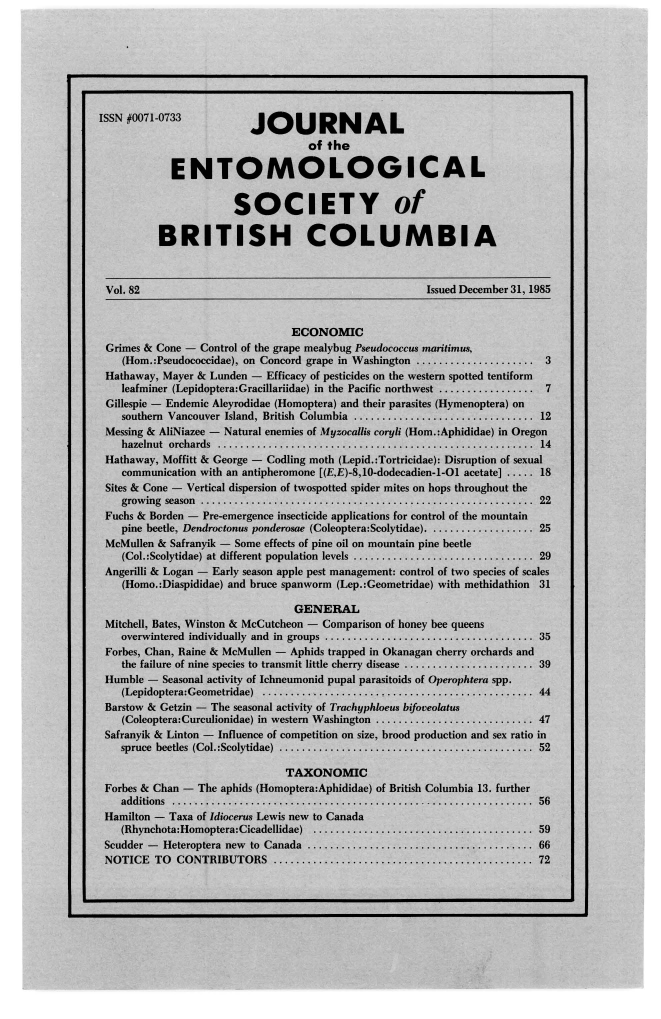Codling moth (Lepid.: Tortricidae): Disruption of sexual communication with an antipheromone [(<i>E,E</i>)-8,1O-dodecadien-1-O1 acetate]
Keywords:
Codling moth, <i>Cydia pomonella</i>, Lepidoptera, TortricidaeAbstract
When broadcast applications of [E, E]-8,10-dodecadien-1l-ol acetate an antipheromone of the codling moth, <i>Cydia pomonella</i> (L.), were made to apple or pear orchards, the catch of male codling moths was reduced in traps baited with either synthetic sex pheromone or virgin females. When the antipheromone, at a rate of 11.25g AI/0.4 ha was applied broadcast to pear trees using a ground dispenser, male response to pheromone- or female-baited traps was completely inhibited for 9 days with no significant reduction thereafter. Based on these and earlier results, it is concluded that (E,E)-8,10-dodecadien-1l-o1 acetate inhibits male codling moth response, whether the sources are placed in close proximity to the attractive agent or distributed in a broadcast application. These results contradict previous arguments that antipheromones as a group may not be effective in the field when used to permeate large volumes of air.References
Descoins, C. and C.A. Henrick. 1972. Sterio-selective syntheses of a sex attractant of the codling moth, Tetrahedron Lett. 30:2999-3002.
Duncan, D.B. 1955. Multiple range and multiple E tests. Biometrics 11:1-42.
George, D.A., L.M. McDonough, D.O. Hathaway, and H.R. Moffitt. 1975. Inhibitors of sexual attraction of male codling moths. Environ. Entomol. 4:606-608.
Hathaway, D.O., T.P. McGovern, M. Beroza, H.R. Moffitt, L.M. McDonough, and B.A. Butt. 1974. Inhibitors of sexual attraction of male codling moths to the synthetic sex pheromone of virgin females. Environ. Entomol. 3:522-524.
Hathaway, D.O., L.M. McDonough, D.A. George, and H.R. Moffitt. 1979. Antipheromone of the codling moth: Potential for control by air permeation. Environ. Entomol. 8:318-321.
Hoffman, M.P., L.M. McDonough, and J.B. Bailey. 1983. Field test of the sex pheromone of Amobia cuncana (Walsingham) (Lepidoptera: Tortricidae). Environ. Entomol. 12:1387-1390.
Howell, J.F. 1972. An improved sex attractant trap for codling moths. J. Econ. Entomol. 65:609-611.
Hoyt, S.C. 1969. Integrated control of insects and biological control of mites on apple in Washington. J. Econ. Entomol. 62:74-86.
Maitlen, J.C., L.M. McDonough, H.R. Moffitt, and D.A. George. 1976. Codling moth sex pheromone: Baits for mass trapping and population survey. Environ. Entomol. 5:199-202.
Moffitt, H.R. 1974. Confusion with a sex pheromone as a means of controlling codling moth. Report to 4th Meeting, IOBC Working Party on Genetic Control of Codling Moth and Adoxophyes. Wadenswil, Switzerland, Nov. 26-29, 1973. 4 pp.
Moffitt, H.R. and R.E. Short. 1982. A ground mechanism for dispensing insect pheromones to fruit trees. USDA AAT-W-22. 27 pp.
Moffitt, R.R., P.H. Westigard, and D.O. Hathaway. 1979. Pheromonal control of the codling moth and biological control of the pear psylla. Proceedings of the Oregon Horticultural Society. 70:95-96.
Mori, K. 1974. Simple syntheses of sex pheromones of codling moth and red bollworm moth by the coupling of Grignard reagents with allylic halides. Tetrahedron 30:3807-3810.
Quist, J.A. 1966. Approaches to orchard insect control. Colorado Agric. Exp. Sta, Bull. No. 5178. 93 pp.
Shorey, H.H. 1977. Manipulation of insect pests of agricultural crops. Pp. 353-367. In: H.H. Shorey and J.J. McKelvey, Jr. (Eds.). Chemical Control of Insect Behavior. Wiley-Interscience, NY.
Shani, A. and J.T. Klug. 1980. Photoxidation of (Z,E)-9:11-tetradecadieyl acetate, the main component of the sex pheromone of the female Egyptian cotton leafworm (Spodoptera littoralis). Tetrahedron Lett. 21:156-1564.
Siegel, S. 1956. Non-parametric statistics. McGraw-Hill, New York. 312 pp.
Downloads
Published
Issue
Section
License
Authors who publish with the Journal of the Entomological Society of British Columbia agree to the following terms:
-Authors retain copyright and grant the journal right of first publication with the work simultaneously licensed under a Creative Commons Attribution License that allows others to share the work with an acknowledgement of the work's authorship and initial publication in this journal.
-Authors are able to enter into separate, additional contractual arrangements for the non-exclusive distribution of the journal's published version of the work (e.g., post it to an institutional repository or publish it in a book), with an acknowledgement of its initial publication in this journal.
-Authors are permitted and encouraged to post their work online (e.g., in institutional repositories or on their website) prior to and during the submission process, as it can lead to productive exchanges, as well as earlier and greater citation of published work (See The Effect of Open Access).


